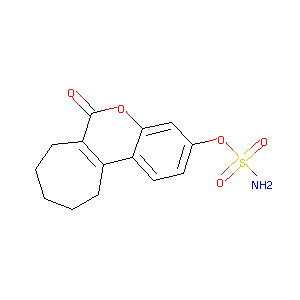| Drug General Information |
| Drug ID |
D0Y6OA
|
| Former ID |
DNC003732
|
| Drug Name |
COUMATE
|
| Indication |
Breast cancer [ICD9: 174, 175; ICD10:C50]
|
Phase 2 |
[1]
|
|---|
| Structure |

|
Download
2D MOL
3D MOL
|
| Target and Pathway |
| Target(s) |
Carbonic anhydrase IV |
Target Info |
Inhibitor |
[2]
|
|---|
| Carbonic anhydrase |
Target Info |
Inhibitor |
[2]
|
| Carbonic anhydrase I |
Target Info |
Inhibitor |
[2]
|
| Carbonic anhydrase XIV |
Target Info |
Inhibitor |
[2]
|
| Carbonic anhydrase IX |
Target Info |
Inhibitor |
[2]
|
| Carbonic anhydrase VI |
Target Info |
Inhibitor |
[2]
|
| Steryl-sulfatase |
Target Info |
Inhibitor |
[3]
|
| Carbonic anhydrase XII |
Target Info |
Inhibitor |
[2]
|
| Cytochrome P450 19 |
Target Info |
Inhibitor |
[3]
|
| Carbonic anhydrase II |
Target Info |
Inhibitor |
[2]
|
|
BioCyc Pathway
|
Superpathway of steroid hormone biosynthesis
|
|
Estradiol biosynthesis II
|
|
Estradiol biosynthesis I
|
|
KEGG Pathway
|
Nitrogen metabolism
|
|
Proximal tubule bicarbonate reclamationhsa00910:Nitrogen metabolismhsa00910:Nitrogen metabolismhsa00910:Nitrogen metabolismhsa00910:Nitrogen metabolismhsa00140:Steroid hormone biosynthesishsa00910:Nitrogen metabolismhsa00140:Steroid hormone biosynthesis
|
|
Metabolic pathways
|
|
Ovarian steroidogenesishsa00910:Nitrogen metabolism
|
|
Proximal tubule bicarbonate reclamation
|
|
Collecting duct acid secretion
|
|
Gastric acid secretion
|
|
Pancreatic secretion
|
|
Bile secretion
|
|
NetPath Pathway
|
TGF_beta_Receptor Signaling PathwayNetPath_25:FSH Signaling PathwayNetPath_16:IL4 Signaling Pathway
|
|
EGFR1 Signaling Pathway
|
|
PANTHER Pathway
|
Androgen/estrogene/progesterone biosynthesis
|
|
Pathway Interaction Database
|
C-MYB transcription factor networkhif1_tfpathway:HIF-1-alpha transcription factor network
|
|
PathWhiz Pathway
|
Gastric Acid ProductionPW000045:Androgen and Estrogen MetabolismPW000045:Androgen and Estrogen Metabolism
|
|
Reactome
|
Erythrocytes take up carbon dioxide and release oxygen
|
|
Erythrocytes take up oxygen and release carbon dioxide
|
|
Reversible hydration of carbon dioxideR-HSA-1237044:Erythrocytes take up carbon dioxide and release oxygen
|
|
Reversible hydration of carbon dioxideR-HSA-1475029:Reversible hydration of carbon dioxideR-HSA-1234158:Regulation of gene expression by Hypoxia-inducible Factor
|
|
Reversible hydration of carbon dioxideR-HSA-1475029:Reversible hydration of carbon dioxideR-HSA-1660662:Glycosphingolipid metabolismR-HSA-1475029:Reversible hydration of carbon dioxideR-HSA-211976:Endogenous sterolsR-HSA-1237044:Erythrocytes take up carbon dioxide and release oxygen
|
|
Reversible hydration of carbon dioxide
|
|
WikiPathways
|
Reversible Hydration of Carbon Dioxide
|
|
Uptake of Carbon Dioxide and Release of Oxygen by Erythrocytes
|
|
Uptake of Oxygen and Release of Carbon Dioxide by ErythrocytesWP2770:Reversible Hydration of Carbon Dioxide
|
|
Uptake of Oxygen and Release of Carbon Dioxide by ErythrocytesWP2770:Reversible Hydration of Carbon DioxideWP2877:Vitamin D Receptor Pathway
|
|
Regulation of Hypoxia-inducible Factor (HIF) by OxygenWP2770:Reversible Hydration of Carbon DioxideWP697:Estrogen metabolism
|
|
Vitamin D Receptor Pathway
|
|
Sphingolipid metabolismWP2770:Reversible Hydration of Carbon Dioxide
|
|
miR-targeted genes in muscle cell - TarBase
|
|
miR-targeted genes in leukocytes - TarBase
|
|
miR-targeted genes in epithelium - TarBaseWP702:Metapathway biotransformation
|
|
Tryptophan metabolism
|
|
Oxidation by Cytochrome P450
|
|
Ovarian Infertility Genes
|
|
Metabolism of steroid hormones and vitamin D
|
|
FSH signaling pathway
|
|
Integrated Breast Cancer Pathway
|
|
Phase 1 - Functionalization of compoundsWP2770:Reversible Hydration of Carbon Dioxide
|
|
Uptake of Oxygen and Release of Carbon Dioxide by Erythrocytes
|
| References |
| REF 1 | Irosustat: a first-generation steroid sulfatase inhibitor in breast cancer. Expert Rev Anticancer Ther. 2011 Feb;11(2):179-83. |
|---|
| REF 2 | Bioorg Med Chem Lett. 2008 Aug 1;18(15):4282-6. Epub 2008 Jul 5.Carbonic anhydrase inhibitors. Interaction of the antitumor sulfamate EMD 486019 with twelve mammalian carbonic anhydrase isoforms: Kinetic and X-ray crystallographic studies. |
|---|
| REF 3 | J Med Chem. 2010 Mar 11;53(5):2155-70.Highly potent first examples of dual aromatase-steroid sulfatase inhibitors based on a biphenyl template. |
|---|